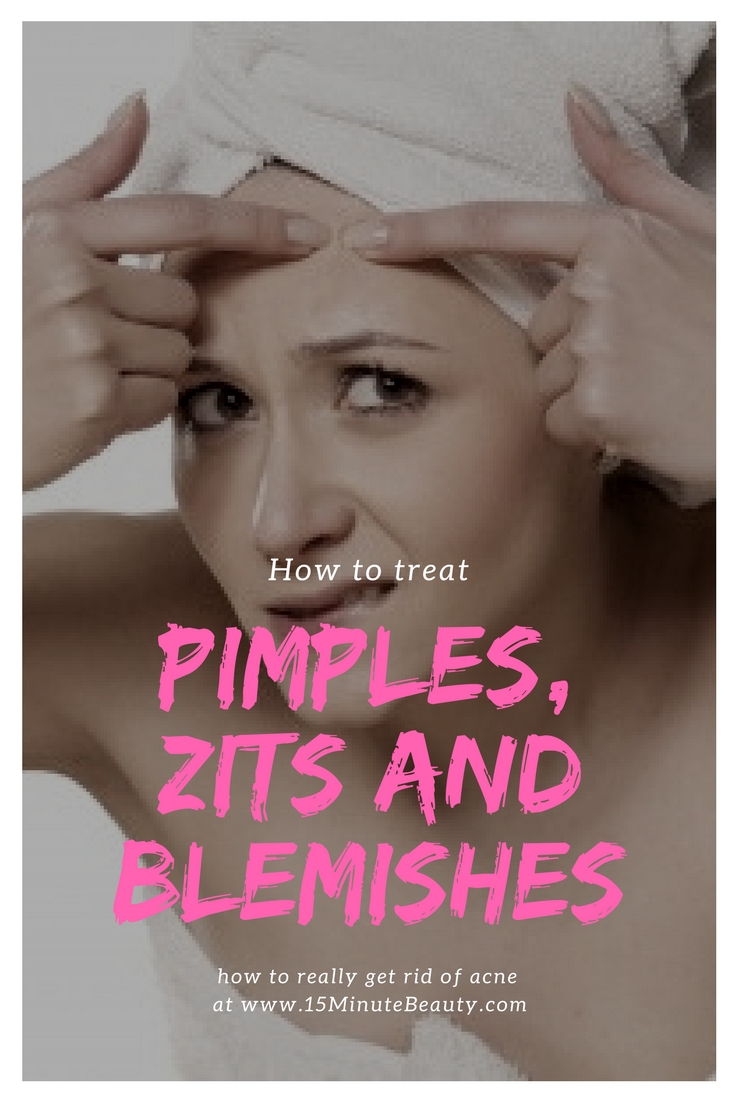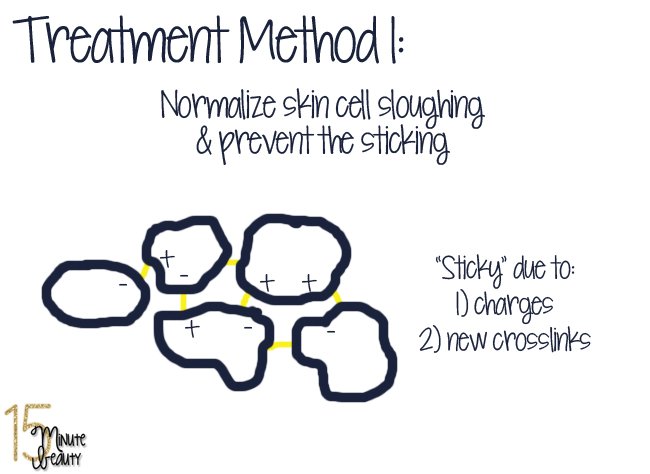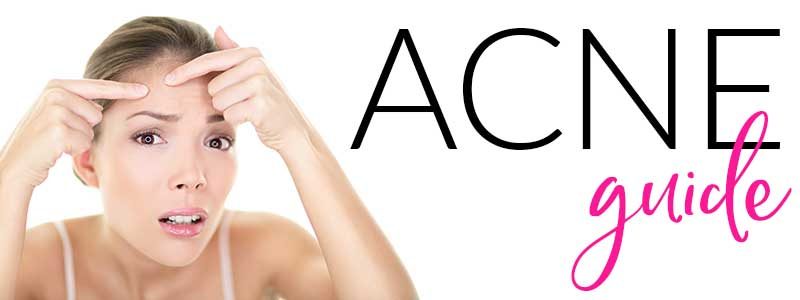We all want clear skin, especially if you have been suffering from acne. Pimples, blemishes, zits… no matter what you call them, you don’t want to have them on your face. But do you feel like you’re piling pimple cream on to your face and the only result is dry, flaky skin that happens to have even more zits?
If you want clear skin, you need to take a systematic approach to treating pimples. First, make sure you have read the basics of how pimples form, because it will make the treatment approach much easier to understand!
How to Treat Acne
When choosing products to treat your acne, it is best to target acne via different routes. Most dermatologists think of including these product types in an entire regimen:
1. Exfoliant
The cells within the hair follicles aren’t sloughing properly and they’re clogging the pore. Exfoliating the surface will help to clear some of them out.
2. Antimicrobial
P. acnes is the main bacteria involved in the development of acne. We don’t fully understand the role this bacteria plays in acne, but it much more likely to be found on the skin of those with acne and in higher numbers. It certainly plays a role in inflammation of pimples. As well, reducing the amount of bacteria has been found to decrease acne.
The main issue with treating P. acnes is bacterial resistance. Up to 60% of people have a strain that easily becomes resistant to the most commonly used antibiotics for acne. Combining the antibiotic with another agent, such as benzoyl peroxide, can prevent the resistance from becoming an issue.
3. Retinoid
There are a lot of caveats to using a retinoid (they’re not pregnancy safe, they can be very irritating to the skin), but retinoids will help blemishes many ways. For example, they regulate the skin cell sloughing. More below.
4. Anti-Inflammatory
Obviously if you’ve ever had a big pimple then you will know that they are full of pus. Which is from all of that inflammation. And this will make the pimple much worse as well, making it harder to remove everything from the blemish, and clean up the mess. The inflammation also makes scarring and post-pimple hyperpigmentation much more likely.
Retinoids in Acne Treatment
The first way to treat acne is to start up at the very beginning of that acne circle of death. The skin cells that are sloughed off have 2 reasons they are sticky and clog things up. The first is that they have slightly different charges on their cell surface, think of them as a bunch of little magnets. Little positive and negative areas line up and keep the cells close together. Once this has happened, an enzyme (transglutaminase) creates little cross bridge connections holding the cells together.
Retinoids will actually treat both of those issues. First, they help to normalize the rate at which the skin cells slough off. The cells that do slough off (at their newly improved rate) will have reduced charges and overall the levels of transglutaminase (and therefore cross bridges) are reduced as well. Blemishes under retinoid treatment are less cohesive and looser. You’re less likely to have the whole follicle plug up and create the blemish, and then when it does the decrease in compactness means that other treatments will be able to penetrate into the blemish more easily. It’s a win-win all around.
Antibiotics and Antimicrobials in Treating Pimples
So, remember when I said that bacteria will infiltrate into the whole sebum-white cell-sloughed skin cell mess? It only makes sense that getting rid of the bacteria will help to stop the downward spiral of a pimple. Less bacteria=less inflammation=less pus, etc.
There are 2 main ways to treat the bacteria. The first is with Benzoyl Peroxide. Benzoyl Peroxide will create free radicals (read more about that in my antioxidants in skin care post), and those will directly attack and kill the bacteria. Keep in mind that due to the free radicals you’ll see damage also to the area’s skin cells, so there is a potential for speeding up aging.
The second way to treat the bacteria is obviously with antibiotics! Usually Clindamycin or Erythromycin are used. Both work equally well, though there’s more risk of bacteria becoming resistant with Erythromycin. When used in combination with Benzoyl Peroxide the risk of resistance is lower. Both of these anti-biotics also work as anti-inflammatories. Both of these antibiotics need to be prescribed.
Finally, you’ll sometimes see Sulfur (or Sodium sulfacetamide) used as the anti-biotic in over the counter meds. Sulfur can also work on the rate of skin cell sloughing, though it won’t affect the charges and enzyme levels like a retinoid.
Clear Out Your Pores
So, obviously cleaning the junk out of the pimple is a good thing. You should not do this by popping the pimple. That follicle won’t only push everything out the pore, but it will likely also rupture back into the skin, spreading the inflammation and bacteria, resulting in an even bigger mess. Extractions can be performed by those trained to do it properly (such as an esthetician), or you could remove things from your pores using a mask like the Gelatin Mask to pull everything out. I’m also a big fan of a mud mask.
Alpha and Beta Hydroxy Acids are also great for helping to clear out the hair follicle. BHAs like Salicylic Acid are more effective because they are lipid soluble, so can penetrate into the sebum clogging the follicle much more easily. Note that Salicylic Acid is also anti-inflammatory.
Decrease Inflammation
I’m sure we’ve all seen in magazines the recommendations to head to your dermatologist for a steroid injection if you get a big blemish the day of an event. It really does work. Bringing down the inflammation makes the swelling go away, the redness is gone, and while that little plug of sebum and sloughed cells is still present, the blemish is much less apparent. If only it was always this easy!
There are a few ways to bring down inflammation to help acne. The first way is obviously steroids, but this should be avoided at all costs. You can have thinning of the skin from steroid use (steroid atrophy), but use of topical steroids can even cause “steroid acne”. So, definitely no steroids! Instead, take advantage of the anti-inflammatory side effects of some of the other treatments, such as topical antibiotics and Salicylic Acid.
Reduce Oil Production
To help decrease sebum production you can use Retinoids (oral and topical both decrease oil production), or a hormonal treatment such as a birth control pill. There aren’t any other ways to really decrease oil production, but you should also remember to not do things that increase oil production. Over washing of the skin will increase oil production quite a bit, so definitely stick to 2x a day at most.
Give It Time
You may have noticed something about all of the above Acne treatments. Very few of them work on blemishes that you already have. Instead, they work on changing the way your skin acts, so they prevent future blemishes. Which means that rather than seeing results quickly, you’ll need to wait about 6-8 weeks to really see a result.
If you want to see immediate results, you should look for Salicylic Acid, Benzoyl Peroxide and steroids (with your physician). I’ve also had results using heat, with either a warm compress or my Tanda Zap.
Medical Help
Keep in mind that not everything that looks like acne, is actually acne. If you’ve tried the typical over the counter treatments without any effect, then it is definitely time to head to your doctor. There’s a huge list of alternative diagnoses, but they include things like Pityrosporum folliculitis, Rosacea, and Seborrheic dermatitis.
So, that’s acne and acne treatment made super simple. Obviously there’s a lot more to this than I’ve explained (I’m but a simple pediatric intensivist, not a dermatologist), and when in doubt I recommend seeing your doctor. Most primary care doctors do treat a lot of derm issues (we did a lot of rashes and acne back in my general peds days), and if needed they’ll refer you on to a dermatologist.










 I’m a doctor, a mommy and a bit of a beauty addict. If you let me, I can take 2 hours to get ready in the morning. Really. I'm on a quest for faster beauty that works!
I’m a doctor, a mommy and a bit of a beauty addict. If you let me, I can take 2 hours to get ready in the morning. Really. I'm on a quest for faster beauty that works!
This is a great thorough review, Christine! I will share this with my skin-savvy readers.
This is such great advice! I was prescribed Lymecyline antibiotics for my mild acne, and combined with a good ol' face wash every morning and night, my face has never been so clear!
Another great post!
Jennifer xx
Please check out my blog at asprinklingofeuphoria.blogspot.co.uk
This is excellent! I have had acne for 50 year (amazing but truly I've had it since I was 10 and am soon turning 60)and you have covered everything that they know today about acne. One the biggest lessons I learned was the need to always moisterize no matter how oily your face seemed. Like you explained so well, all those dry flakey cells are the devil when it comes to zit formation!
Wonderful post thanks – so helpful! I LOVE using lavender and tea tree oil in acne washes and moisturizers (even have a really nice non greasy recipe for acne serum thats antibacterial) and like your ideas on calming iinflammation Cheers
Thank you for the great info on acne! I've noticed that my 13-year-old daughter is developing acne on her forehead and back. I want to help her but I don't know how to talk to her about it–she is super sensitive about many things and I'm worried she will shut me out even though I'm trying to help (I do speak lovingly & gently to her). Wish me luck 🙂
APE- that can be a hard talk! I HATED whenever it was brought up with me when I was a teen, though part of that might have been because it was my dad who brought it up (he's a pediatrician) and he was prescribing me things that I hated. (I had Gentamycin pads for my face, they made is super dry and tight, though they got rid of the pimples)
Anyways, you might want to check out Bonding over Beauty, it will help you navigate some of those tricky things over the next few years!
Thank you for the encouragement! And I just read your post on Bonding over Beauty–my library doesn't carry it, so I'm going to buy the e-book this evening! What a fantastic resource. Thanks again, Christine!
(April) 🙂
Very well written and informative article on acne! The being patient part is probably the hardest part for everyone!!
Are pimple patches safe for pregnant women? and if so what brands would you recommend?
Please check the brand list, this is very product dependent and not all are safe. There are many already listed in there that are safe.